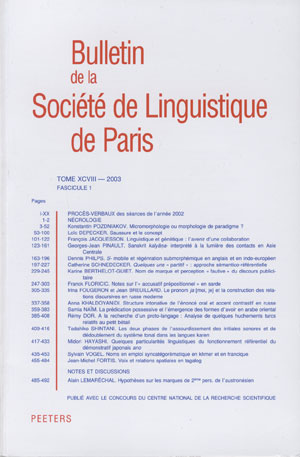 previous article in this issue previous article in this issue | next article in this issue  |

Preview first page |
Document Details : Title: On the mi-na-Gerundives in Hieroglyphic Luwian Author(s): GARNIER, Romain Journal: Bulletin de la Société de Linguistique de Paris Volume: 118 Issue: 1 Date: 2023 Pages: 181-206 DOI: 10.2143/BSL.118.1.3292782 Abstract : The traditional interpretation of HLuw. -mi-na (once -mi-i-na) as a first-person plural indicative has been dismissed by Melchert, who established that these forms are 'gerundives', not showing agreement with the patient, which always stands in the nominative, for instance in the clause: 30 OVIS-sa … ¦DARE-mi-na (KULULU lead strip 2: obv., §1) '30 sheep (are) to be given'. These patient-oriented deontic predicates with nul-copula must reflect a petrified case form of a verbal noun. Melchert cautiously suggested a lenghtened-grade endingless locative (PIE *-mēn > Luw. *-mīn > HLuw. */mīn/ written ‹mi-na›), a reading as */mīn/ built on by Pinault with a different analysis (PIE *-mh1-ḗn [HK]). Differently, García-Ramón proposed an allative to a -mn-stem (viz. PA *-mn-ā), but the regular outcome of non-initial PA *-mn- is HLuw. *-mm-, with assimilation (by contrast with PA *mnā- ‘to see, look upon’ > CLuw. manā- and HLuw. */mana-(-di)/ both with anaptyctic -a-). As a result, the alleged Luwian etymon *piyámmn-ā ‘to give/to be given’ should surface as HLuw. **/piyamma/. No matter how clever these reconstructions may be, they are not compelling, since the -mi-na-forms under consideration are very late and appear in Iron Age Hieroglyphic Luwian only. I rather suggest a phrase *piyámmiy⸗ánni ‘for donation, to give’ with (i) apocope (*piyámmiy⸗án) and (ii) syncope (*piyámmīn), written ‹DARE-mi-na›. This would be the dative of a productive verbal noun in -ámman hosting the postposition ⸗ánni ‘with, for, to’. The seldom spelling ‹mi-i-na› (SULTANHAN §3) could therefore be vindicated as a plene writing, as per Vertegaal. The adduced phonetics are echoed by the evolution of HLuw. */tāwiy⸗ánni/ > */tāwiyán/ > */tāwīn/ ‘towards; against’ (undoubtedly a calque of Aram. l-ʕyn /lǝʕēn/ [prep.] ‘before one’s eyes; face to face; publicly’). L’interprétation traditionnelle de louv. hiér. -mi-na (une fois -mi-i-na) comme la première personne du pluriel de l’indicatif a été rejetée par Melchert, qui a établi que ces formes sont des «gérondifs», lesquels ne s’accordent pas avec le patient, toujours exprimé au nominatif, ainsi dans la phrase: 30 OVIS-sa … ¦DAREmi-na (lamelle de plomb de KULULU 2: recto, §1) «30 moutons (sont) à donner». Ces prédicats déontiques orientés vers le patient et à copule-zéro doivent refléter un nom verbal, à quelque cas fossile. Avec prudence, Melchert avait suggéré un locatif à désinence-zéro sur degré allongé (i.-e. *-mēn > Louv. *-mīn > louv. hiér. */mīn/ noté ‹mi-na›), une interprétation phonétique */mīn/ reprise par Pinault avec une analyse morphologique différente (i.-e. *-mh1-ḗn [de flexion hystérocinétique]). De façon différente, García-Ramón a proposé d’y voir l’allatif d’un thème en -mn (soit anat. com. *-mn-ā), mais le produit phonétique attendu d’anat. com. *-mn- en position médiale est louv. hiér. *-mm-, avec assimilation (contrairement à anat. com. *mnā- «voir, considérer» > louv. cun. manā- et louv. hiér. */mana-(-di)/ – tous deux avec anaptyxe en -a-). Par conséquent, le prétendu étymon louv. *piyámmn-ā «devant être donné» devrait aboutir à louv. hiér. **/piyamma/. Pour habiles qu’elles soient, ces reconstructions n’emportent pas l’adhésion, du fait que les formes en -mi-na- ici étudiées sont très tardives et n’apparaissent pas avant l’Âge du Fer dans ses derniers moments. Je suggère ici une locution *piyámmiy⸗ánni «comme don, pour donner» avec (1) apocope (*piyámmiy⸗án) et (2) syncope (*piyámmīn), noté ‹DARE-mi-na›. Ce serait en propre le datif d’un nom verbal (productif) en -ámman [nt.] suivi par la postposition ⸗ánni «avec, pour, contre». La graphie exceptionnelle ‹mi-i-na› (SULTANHAN §3) pourrait se voir justifiée comme scriptio plena, ainsi que suggéré par Vertegaal. Le traitement phonétique convoqué se retrouve dans la préposition complexe louv. hiér. */tāwiy⸗ánni/ > */tāwiyán/ > */tāwīn/ «vers, contre» (sans doute un calque d’aram. l-ʕyn /lǝʕēn/ [prép.] «devant les yeux, en face, ouvertement»). Der hieroglyphenluwische Wortausgang -mina (einmal auch -mi-i-na geschrieben) hat unterschiedliche Deutungen erfahren. Traditionell wurden diese Formen als 1. Singular Indikativ aufgefaßt. Melchert hat demgegenüber vorgeschlagen, sie als Gerundiva zu interpretieren. Sie kongruieren nicht mit dem direkten Objekt, das im Nominativ steht; so etwa in: 30 OVIS-sa … ¦DARE-mi-na (Bleistreifen KULULU 2, Vorderseite §1) '30 Schafe [sind] zu geben'. Melchert schlägt vor, sie als versteinerte endungslose dehnstufige Lokative eines men-stämmigen Verbalnomens aufzufassen (idg. *-mēn > luw. *-mīn, hieroglyphenluw. ‹-mina› geschrieben). Ebenfalls von *-mīn geht Pinault aus, der dieses aber auf einen hysterokinetischen Stamm idg. *-mh1-ḗn zurückführt. García-Ramón wiederum schlägt einen Allativ eines mn-Stamms vor (anatol. *-mn-ā); anders als anlautendes *mn- (vgl. *mnā- 'sehen' > keilschriftluw. manā-, hieroglyphenluw. /mana-(-di)/, mit Anaptyxe) sollte inlautendes *-mn- aber zu hieroglyphenluw. *-mm- assimiliert werden und z.B. *piyámmn-ā 'zu geben(des)' hieroglyphenluw. **/piyamma/ ergeben. Angesichts der nur hieroglyphenluwischen, d.h. recht späten, Bezeugung verdient m.E. eine innerluwische Erklärung aber den Vorzug gegenüber den verschiedenen urindogermanischen Bildungen. Hier soll daher vorgeschlagen werden, die Formen auf -mi(-i)-na als Dative der für das Luwische typischen und im Hieroglyphenluwischen produktiven Verbalnomina auf -ámman in Verbindung mit der im Luwischen immer nachgestellten Adposition ⸗ánni 'in, mit, für' zu interpretieren, also etwa *piyámmiy⸗ánni 'für das Geben, zu geben', mit (i) Apokope (*piyámmiy⸗án) und (ii) Synkope (*piyámmīn), geschrieben ‹DARE-mi-na› bzw. – mit plene-Schreibung (Vertegaal) – ‹-mi-i-na› (Inschrift SULTANHAN §3). Eine Parallele zu diesen Entwicklungen ist in hieroglyphenluw. */tāwiy⸗ánni/ > */tāwiyán/ > */tāwīn/ 'nach, zu, gegen', das eine Lehnübersetzung von aramäisch l-ʕyn /lǝʕēn/ 'vor den eigenen Augen, gegen, öffentlich' sein dürfte. |
|


